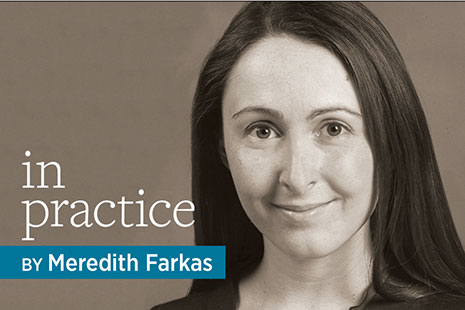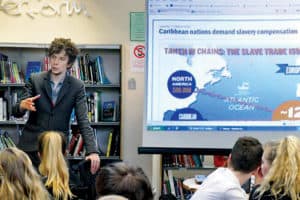
Librarians in academic settings are often focused on outreach to disciplinary instructors. The dream many of us have is for information literacy instruction to be organically embedded into all academic curricula. Real curricular integration is rare, and most instruction happens in a single session requested by the faculty member. However, if information literacy instruction was embedded in all courses in which it made sense, we wouldn’t have enough librarians to teach it all.
Two recent publications envision this type of instruction as a shared responsibility of the librarian and the disciplinary instructor. The Framework for Information Literacy for Higher Education, adopted by the Association of College and Research Libraries (ACRL) in 2016, represents a significant departure from the ACRL Information Literacy Competency Standards for Higher Education. It recognizes that information literacy comprises not just skills but also dispositions and habits of mind, and that librarians should not be the only ones teaching information literacy. The American Association of School Librarians’ Standards for the 21st-Century Learner also includes dispositions that would be impossible to foster in a single instruction session.
Instructors, however, have varying levels of comfort teaching information literacy and varying knowledge of library resources. Most of us have seen terrible library scavenger hunts and assignments that seem to teach students only that the library is a confusing place and research is hard. I see frustrating situations like these as outreach opportunities. In positioning ourselves as experts in information literacy pedagogy, we are not only supporting instructors in their efforts to teach information literacy but are also likely changing some faculty members’ perceptions of librarians.
One option we are exploring at Portland (Oreg.) Community College is developing a toolkit to support faculty in teaching information literacy. The University of Texas at Austin developed a toolkit to support its first-year experience courses, with materials that instructors can use in classes and examples of how faculty and librarians have collaborated to support other classes.
At my library, we started by surveying faculty to find out what kinds of resources they would value and to what learning outcomes they would most likely teach in their courses. We are in the process of collecting learning objects that instructors can revise, remix, and use. The next challenge will be to select a tool in which to store the content and organize it so that faculty can easily find what they need.
Some libraries use LibGuides to create information literacy toolkits because it’s a web-authoring tool to which most librarians have easy access. For a small project, LibGuides might be adequate, but the interface can quickly become visually overwhelming as the amount of content grows. Institutions that already have a learning object repository (LOR) in their learning management system have an ideal option because instructors can easily import content from the LOR into their own online classrooms.
A database-driven CMS, like WordPress or Drupal, would make for easy navigation of a large collection of learning objects. By tagging each object with the learning outcomes it addresses and the type of content (handout, activity, etc.), instructors could browse just the resources that interest them. The Pollak Library at California State University, Fullerton has developed a WordPress-based LOR to support disciplinary faculty as well as their librarians as they teach information literacy.
Whether or not we develop toolkits, many disciplinary faculty will be teaching information literacy, some ably and some not. By offering instructors librarian-created learning objects, we can better ensure that every student has a positive experience learning about information literacy and the library.



Thanks for highlighting the need for online toolkits! At Cal State San Bernardino, we maintain the Critical Information Literacy Laboratory for Faculty: An Online Toolkit for Teaching and Learning: http://library.csusb.edu/cillab/ . If you’re curious, you can read more about its development here: http://acrl.ala.org/IS/instruction-tools-resources-2/pedagogy/primo-peer-reviewed-instruction-materials-online/primo-site-of-the-month/june-2016-site-of-the-month/ We’ll be surveying faculty this summer to get a better idea about its current usage and how we can improve it to better assist them, especially those who will soon be teaching new or revised GE courses that have an attached CIL outcome.